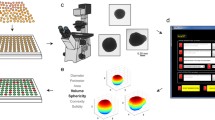Summary
A new in vitro method for determining the clonogenicity of mammalian cells in culture is described. The method is based on packaging clonogens into agglomerates of non-proliferating, but metabolically active, HeLa cells. These agglomerates, termed hybrid spheroids, provide an in vivo-like environment for entrapped test cells, offering a realistic system for prospective tumor control studies. Clonogenicity is determined by varying the number of test cells per hybrid spheroid so that some, but not all, spheroids give rise to macrocolonies. From the fraction of non-colony forming spheroids, the average number of clonogens per spheroid can be calculated, and the survival of irradiated test cells determined. In this fashion survival curves were obtained for HeLa, B-16 and HEp3 cells which corresponded to survival curves obtained in the conventional manner. The clonogenicity of cells, derived from a human maxillar melanoma surgical specimen was also determined by the hybrid spheroid method. With this method, plating efficiency increased in those cells which normally plate poorly, such as tumor cells, thus enabling survival measurements when this is not practical using conventional methods.
Similar content being viewed by others
References
Ajani JA, Baker FL, Spitzer G, Kelly A, Brock W, Tomasovic B, Singletary SE, McMurtrey M, Plager C (1987) Comparison between clinical response and in vitro drug sensitivity of primary human tumors in the adhesive tumor cell culture system. J Clin Oncol 5:1912–1921
Arundel C, Bock S, Brock WA, Tofilon PJ (1987) Radiosensitization of primary human tumor cell cultures by N-methylformamide. Int J Radiat Oncol Biol Phys 13:753–757
Baker F, Spitzer G, Ajani JA, Brock WA, Lukeman J, Pathak S, Tomasovic B, Thielvoldt D, Williams M, Vines C, Tofilon PJ (1986) Drug and radiation sensitivity measurements of successful primary monolayer culturing of human tumor cells using cell-adhesive matrix and supplemented medium. Cancer Res 46:1263–1274
Brock WA, Williams M, Bhadkamkar VA, Spitzer G, Baker F (1985) Radiosensitivity testing of primary cultures derived from human tumors. In: Proceedings of the Third International Meeting on Progress in Radio-Oncology. Karcher, Vienna, pp 185–194
Courtenay VD (1984) A replenishable soft agar colony assay for human tumor sensitivity testing. Recent Results Cancer Res 94:17–34
Durand RE (1975) Cure, regression and cell survival: a comparison of common radiobiological endpoints using an in vitro tumor model. Br J Radiol 48:556–571
Fletcher R (1972) Fortran subroutines for minimization by Quasi-Newton methods. AERE, p 7125
Gershman H, Drumm J, Culp L (1976) Sorting of normal and virus-transformed cells in cellular aggregates. J Cell Biol 68:276–286
Gilbert CW (1974) A double minus log transformation of mortality probabilities. Int J Radiat Biol 25:633–634
Gordon JR, Quigley JP (1986) Early spontaneous metastasis in the human epidermoid carcinoma HEp3/chick embryo model: contribution of incidental colonization. Int J Cancer 38:437–444
Griffiths P, Hill ID (1985) Applied statistics algorithms. Ellis Hopwood, Chichester
Hahn GM, Rockwell S, Kallman RE, Gordon LF, Frindel E (1974) Repair of potentially lethal damage in vivo in solid tumor cells after x-irradiation. Cancer Res 34:351–354
Hamburger AW, Salmon SE, Kim MB, Trent JM, Soehnlen BJ, Alberts DS, Schmidt HJ (1978) Direct cloning of human ovarian carcinoma cells in agar. Cancer Res 38:3438–3447
Hill RP, Ng R, Warren BF, Bush RS (1979) The effect of intercellular contact on the radiation sensitivity of KHT sarcoma cells. Radiat Res 77:182–192
Hopwood LE (1982) Response of human tumor cells from biopsy specimens to radiation and hyperthermia. Int J Radiat Oncol Biol Phys 8 [Suppl I]:72
Jones AC, Stratford IJ, Wilson PA, Peckham MJ (1982) In vitro cytotoxic drug sensitivity testing of human tumor xenografts grown as multicellular tumor spheroids. Br J Cancer 46:870–879
Lange CS, Gilbert CW (1968) Studies on the cellular basis of radiation lethality. III. The measurement of stem cell repopulation probability. Int J Radiat Biol 14:373–388
Munro TR, Gilbert CW (1961) The relation between tumor lethal doses and the radiosensitivity of tumor cells. Br J Radiol 34:246–251
Moore JV, Hendry JH (1984) Relationship of clonogenic cells and “tumor-rescuing cells”, modelled in irradiated spheroids in vitro. Br J Radiol 57:935–937
O'Neil R (1971) Function minimization using a simplex procedure algorithm. Appl Statist 47:38–400
Pourreau-Schneider N, Malaise E (1981) Relationship between surviving fractions using the colony method, the LD50, and the growth delay after irradiation of human melanoma cells grown as multicellular spheroids. Radiat Res 85:321–332
Rofstad EK, Wahl A, Brustad T (1986) Radiation response of human melanoma multicellular spheroids measured as single cell survival, growth delay, and spheroid cure: Comparisons with the parent tumor xenograft. Int J Radiat Oncol Biol Phys 12:975–982
Rofstad EK, Wahl A, Tveit KM, Monge OR, Brustad T (1985) Survival curves after x-ray and heat treatments for melanoma cell derived directly from surgical specimens of tumors in man. Radiother Oncol 4:33–44
Selby P, Buick RN, Tannock I (1983) A critical appraisal of the “human stem-cell assay”. N Engl J Med 308:129–134
Sinclair WK, Morton RA (1964) Recovery following x-irradiation of synchronized Chinese hamster cells. Nature 203:247–250
Sutherland RM (1988) Cell and environment interaction in tumor microregions: The multicell spheroid model. Science 240:177–184
Sutherland RM, Durand RE (1984) Growth and cellular characteristics of multicell spheroids. Recent Results Cancer Res 95:24–49
Tofilon PJ, Buckley N, Deen DF (1981) Effect of cell-cell interactions on drug sensitivity and growth of drug-sensitive and resistant tumor cells in spheroids. Science 226:262–864
Yuhas JM (1983) Clonogenic assays for predicting the response of solid tumors to therapy. In: Fletcher GH, Nervi G, Withers HR (eds) Biological bases and clinical implications of tumors resistance. Masson, New York, pp 383–390
Yuhas JM, Li AP, Martinez AO, Ladman AJ (1977) A simplified method for production and growth of multicellular tumor spheroids. Cancer Res 37:3639–3643
Author information
Authors and Affiliations
Rights and permissions
About this article
Cite this article
Djordjevic, B., Lange, C.S. Clonogenicity of mammalian cells in hybrid spheroids a new assay method. Radiat Environ Biophys 29, 31–46 (1990). https://doi.org/10.1007/BF01211233
Received:
Accepted:
Issue Date:
DOI: https://doi.org/10.1007/BF01211233




